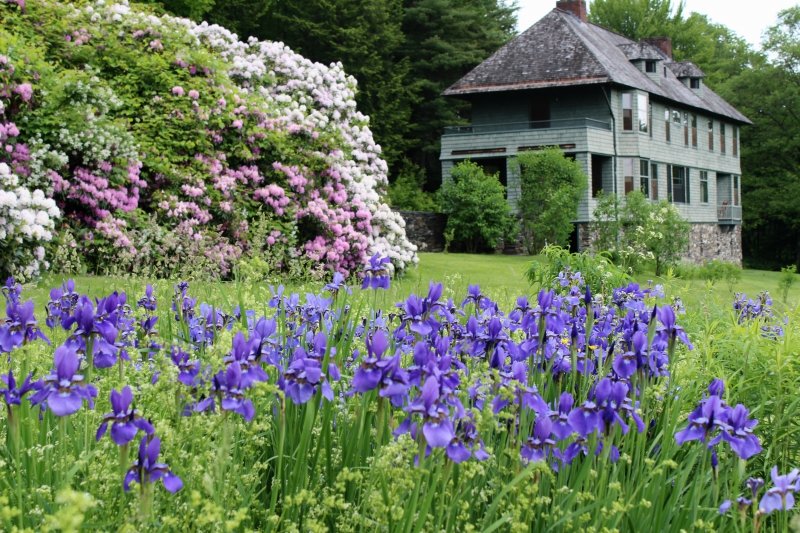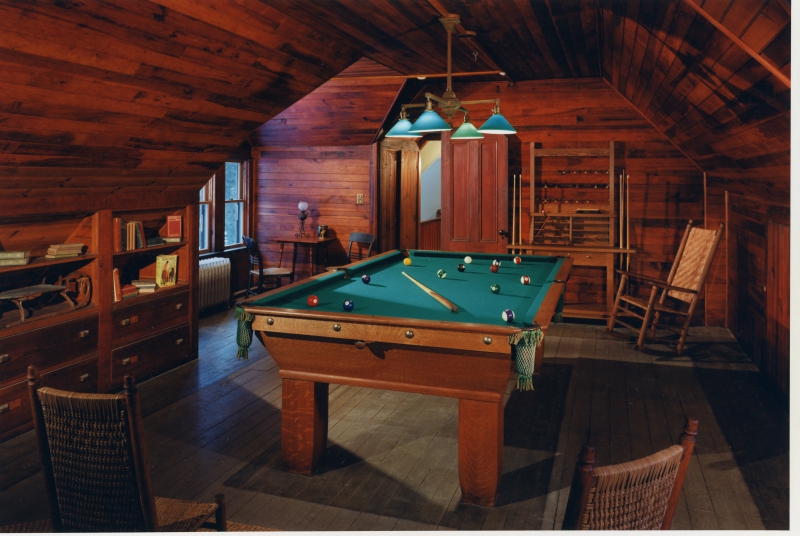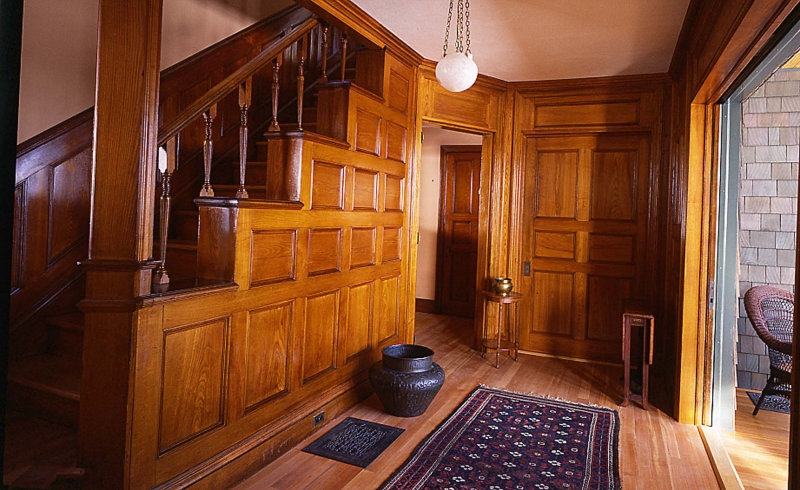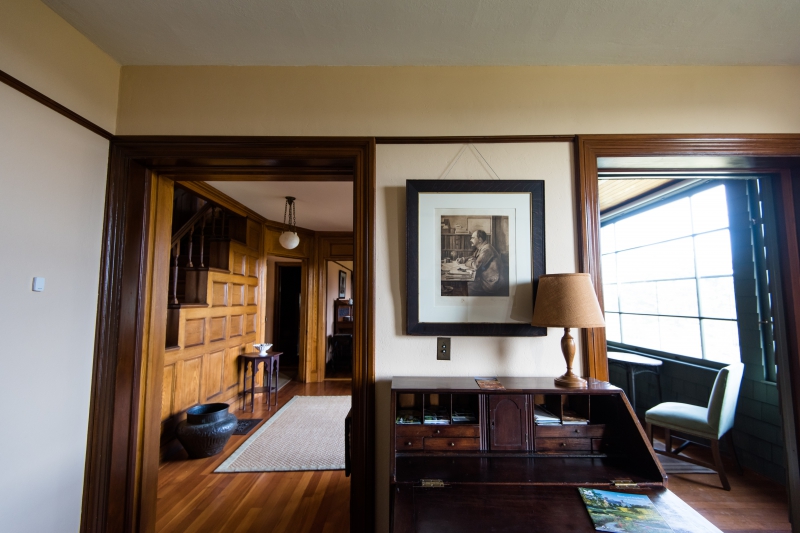
“Ninety feet long and 30 feet wide, on a high foundation of solid mortared rocks gave the Kiplings “a skunk-proof basement,” Rudyard wrote in his memoir, Something of Myself. “ He wanted the house to resemble a ship riding the hillside like a wave. At the southerly bow his first-floor study and the second-floor nursery open onto verandas.
By Katherine P. Cox
Rudyard Kipling, the British Nobel-prize winning author, penned The Jungle Book, the Just So Stories, and Captains Courageous in his beloved Dummerston home, which he named Naulakha, Hindi for “priceless jewel.” The house — also called the Rudyard Kipling House — sits high on a hill, with all of the rooms facing east to capture the sweeping views of the Connecticut River Valley and Mount Monadnock in New Hampshire.
The desk where he wrote is still there. And if you’re feeling inspired, you can sit at his desk and write, too. You can also sleep in his bed, cook in the kitchen, dine at his table, and play billiards in his game room. It’s all still there, just as it was when he lived there in 1892.
Painstakingly restored to its original condition with much of the original furnishings, Naulakha can be rented for a vacation stay through Landmark Trust USA. It sleeps eight people, has a fully equipped kitchen, up-to-date bathrooms, and extensive gardens. It even boasts the state’s first tennis court, which guests can still enjoy.
Landmark Trust USA, based down the road in Dummerston, is celebrating its 25th anniversary of restoring historic properties, and 25 years since the Kipling home was purchased. The property was restored and opened for guests 100 years after its construction. It had been abandoned for 50 years by the time the non-profit organization purchased the property in 1992.
Indeed, this treasure was “sinking into the ground,” says Kelly Carlin, operations manager at Landmark Trust. “But all the furniture was still there, the pictures were still on the walls, and the curtains were on the windows.” All there, but not in good shape, Carlin says. The furniture, much of which was discovered in a nearby barn, also had to be restored.

On the third floor is a playroom complete with the billiard table Rudyard requested to match one he’d seen in the home of Mark Twain.
“We not only rescue houses, we rescue furniture,” she adds. The original pocket doors and ash paneling were found in a barn at the neighboring Scott Farm “under a hundred years of bat guano.”
Kipling had a hand in the design, directing the architects to create a home that resembled a ship. It’s 90 feet long and 22 feet wide. The kitchen is in the stern – “it’s what moves the ship forward,” Carlin explains – and his study was in the bow, “where he could be the captain.”
The folks at Landmark Trust knew exactly what the house was supposed to look like because they had tracked down the architect’s plans in New York City and curated photographs and letters depicting life at Naulakha. Family life famously included nightly stories that Kipling would tell his children; they would plead with him, “Daddy, tell them just so.” These he later compiled in his Just So Stories.
While Naulakha was one of Bombay-born Kipling’s favorite places to live, he and his family lived there just four years before returning to England. A friend of the Kiplings, Mary Cabott, along with her brother Will, sister Grace, and Grace’s husband, Frederick Holbrook, purchased the property in 1903. It remained in the Holbrook family, who also owned the Scott Farm, which borders Naulakha, until the Landmark Trust purchased it.

When the loggia’s oversize window and doors are are open, the morning sun illuminates the center hall, bringing in fresh air.
The nearby Carriage House, which was built as a barn, had been converted by the Kiplings into living quarters for their coachman and family, and it, too was restored and made available for short-term rentals.
When Naulakha was purchased, Landmark Trust USA was part of Landmark Trust UK, which has rescued and restored more than 200 properties in the United Kingdom, France and Italy. It was founded in 1965 by John and Christian Smith to protect historical structures and allow the public to enjoy them by living in them briefly.
“It’s about historic preservation,” Carlin says, adding that the organization’s mission is based on Smith’s philosophy that “if you give people a one-on-one experience with history, they’re more inclined to support historic preservation.” These are not house museums where people peer over velvet ropes but instead are historically significant homes that have been rescued, restored, and given new life as vacation rentals, Carlin notes.
At Naulakha, for example, you can walk the same garden paths that Rudyard Kipling, his illustrious guests, and his family walked.
“When we restore a property we do it using what we call conservative repair. We aren’t trying to make it new; we’re trying to make it what it once was,” Carlin says.

From her study, Caroline could keep a watchful eye on the center hall, left, and loggia, right, to intercept intrusive reporters and autograph hounds.
She explains that conservation, properly undertaken, is exacting:
“If changes have been made to the house, we will reverse those changes back to what it was originally.” That said, the trust does not skimp on modern conveniences such as refrigerators, stoves, dishwashers, and washers and dryers.
Naulakha and its Carriage House were funded and restored by the Landmark Trust UK because of Kipling’s connection to England as a British author. The group was reluctant to fully fund other properties Landmark USA identified, and the U.S. non-profit became a separate organization that has since purchased and restored three other properties in the area to their former splendor for vacationers to enjoy as they unplug from the demands of contemporary life: the Amos Brown House, the Dutton Farmhouse, and the Sugarhouse.
“There’s something compelling and interesting about each of the properties, which made them choices for us to rescue and restore,” Carlin says.
The Amos Brown House in Whitingham, built in 1802, was opened to guests in 2003 after two years of restoration work. The farm began to decline in the late 19th century and by 1930 was no longer a working farm. Carthusian monks then lived there for 20 years; by the 1990s the property had been abandoned and was given to the local historical society.
Landmark Trust bought the property in 2000 and set about rescuing its crumbling house, which was built from bricks made on the farm. The restoration provided an opportunity to teach people how to make bricks on site, Carlin said, using methods and materials dating to the 19th century. “We used the restoration as an opportunity to teach the almost-lost arts,” Carlin says.
At Dutton Farmhouse, which, along with the Sugarhouse, is on the historic Scott Farm property in Dummerston that borders Naulakha, layers of wallpaper were scraped down to the colorful original, which the Trust had reproduced and rehung in the house. Built in the Greek Revival style on a granite plinth, the house also boasts a mantel with carved seashells, and interesting carved woodwork.
It was part of a large, successful farm at one point that “has a very interesting history that tells a lot about what it was like to live in Vermont in the 1800s,” Carlin says. “It tells a Vermont farming story, as does the Amos Brown House.” This was opened to guests in 2004.
The Sugarhouse, which is much smaller than the other homes and sleeps two, has its own story to tell. The Scott Farm was one of the first farms in America to produce and then ship its maple syrup, Carlin says.
“How often do you get to stay in a sugarhouse? It’s pretty neat,” she adds. “The sugarhouse is part of the farm’s historic fabric.” It’s surrounded by maple trees that produce maple syrup today.
Location is clearly a draw for guests at Landmark Trust vacation homes, who experience authentic Vermont country life while staying in beautiful houses with great architecture, lovingly renewed.
Young Writers’ Award
As part of its 25th anniversary, Landmark Trust USA has established the Rudyard Kipling Young Writers Award competition for Windham County students in grades 4-6. A distinguished panel of judges will review entries with awards, honorable mentions, and overall best presented on stage at the Latchis Theater on Saturday, June 4.
For more information on the Young Writers’ Award, Landmark Trust USA and renting its historic properties, visit http://www.landmarktrustusa.org.





















































